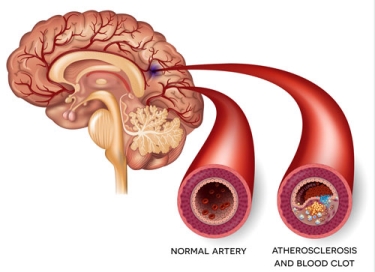Ischemic stroke explained
- Category: Blog, Neuromedicine
- Posted On:
- Written By: King's Daughters Health
 Ischemic stroke is the most commonly occurring type of stroke, affecting about 200,000 Americans annually. The word, ischemic, means an insufficient supply of blood to a part of the body caused by an obstruction. An ischemic stroke occurs when blood cannot get to the brain.
Ischemic stroke is the most commonly occurring type of stroke, affecting about 200,000 Americans annually. The word, ischemic, means an insufficient supply of blood to a part of the body caused by an obstruction. An ischemic stroke occurs when blood cannot get to the brain.
There are two types of ischemic stroke: embolic and thrombotic.
A stroke caused by a blood clot or a fragment of plaque that has broken loose somewhere else in the body and traveled to the brain is called an embolic stroke. The clot/fragment travels through the blood vessels of the brain until it gets caught in a vessel too small to allow it to pass. The material lodges there, starving that part of the brain of blood and oxygen. People with atrial fibrillation are at increased risk for this type of stroke and, for this reason, are often prescribed blood thinners to help prevent clot formation.
When a clot forms inside one of the arteries that supplies blood to the brain, it’s called a thrombotic stroke. These strokes often occur in people who have high LDL cholesterol and “hardening of the arteries.” Clots form more easily on the rough interior walls of the arteries affected by atherosclerosis. When the clot forms inside a large blood vessel (the most common), it’s called a large vessel thrombosis. High cholesterol is a risk factor for this type of stroke.
When the clot forms in a very small vessel, it’s called small vessel disease. High blood pressure is linked to this type of stroke.
What you can do
Talk to your doctor about your stroke risk. If your total cholesterol and LDL levels are high, or your HDL levels are low, follow their recommendation about how to better manage your cholesterol. This may include diet, exercise and medications. Be aware of your blood pressure and work with your healthcare provider to manage it. Lose weight, stop smoking and eat a healthy diet. If you have atrial fibrillation, follow your doctor’s orders carefully.
Remember stroke’s warning signs:
F – Face drooping, especially on one side
A – Arm weakness or inability to move
S – Slurred speech or impaired vision
T – Time is of the essence. Call 9-1-1 and get transported to the nearest emergency room immediately. Remember, time lost is brain lost.